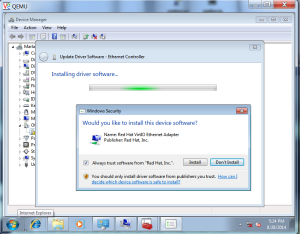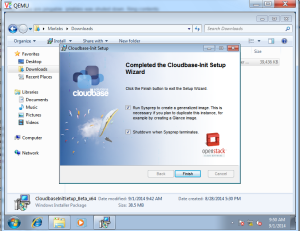Adding first network
On Network Node
#Add the integration bridge:
ovs-vsctl add-br br-int
#Add the external bridge:
ovs-vsctl add-br br-ex
#Add a port to the external bridge that connects to the physical external network interface:
#Replace INTERFACE_NAME with the actual interface name. For example, eth2 or ens256.
ovs-vsctl add-port br-ex eth2
On Controller Node
[root@controller1 ~]# source /root/admin-openrc.sh
[root@controller1 ~]# neutron net-create ext-net --shared --router:external=True
Created a new network:
+---------------------------+--------------------------------------+
| Field | Value |
+---------------------------+--------------------------------------+
| admin_state_up | True |
| id | 2fdfff06-5837-4ab8-b971-c08696165e9d |
| name | ext-net |
| provider:network_type | gre |
| provider:physical_network | |
| provider:segmentation_id | 1 |
| router:external | True |
| shared | True |
| status | ACTIVE |
| subnets | |
| tenant_id | 8c9fb6577a1e45879f35e3e43b34de58 |
+---------------------------+--------------------------------------+
[root@controller1 ~]#
[root@controller1 ~]# neutron subnet-create ext-net --name ext-subnet --allocation-pool start=192.168.10.129,end=192.168.10.254 --disable-dhcp --gateway 192.168.10.1 192.168.10.128/24
Created a new subnet:
+------------------+------------------------------------------------+
| Field | Value |
+------------------+------------------------------------------------+
| allocation_pools | {"start": "192.168.10.129", "end": "192.168.10.254"} |
| cidr | 192.168.10.0/24 |
| dns_nameservers | |
| enable_dhcp | False |
| gateway_ip | 192.168.10.1 |
| host_routes | |
| id | 09ec246e-4b1d-4fcb-babc-fdfd73ad13d0 |
| ip_version | 4 |
| name | ext-subnet |
| network_id | 2fdfff06-5837-4ab8-b971-c08696165e9d |
| tenant_id | 8c9fb6577a1e45879f35e3e43b34de58 |
+------------------+------------------------------------------------+
[root@controller1 ~]# neutron net-create demo-net
Created a new network:
+---------------------------+--------------------------------------+
| Field | Value |
+---------------------------+--------------------------------------+
| admin_state_up | True |
| id | df86ab38-57f2-432b-8ea8-ef30ceb72607 |
| name | demo-net |
| provider:network_type | gre |
| provider:physical_network | |
| provider:segmentation_id | 2 |
| shared | False |
| status | ACTIVE |
| subnets | |
| tenant_id | 8c9fb6577a1e45879f35e3e43b34de58 |
+---------------------------+--------------------------------------+
[root@controller1 ~]# neutron subnet-create demo-net --name demo-subnet --gateway 10.0.0.1 10.0.0.0/24
Created a new subnet:
+------------------+--------------------------------------------+
| Field | Value |
+------------------+--------------------------------------------+
| allocation_pools | {"start": "10.0.0.2", "end": "10.0.0.254"} |
| cidr | 10.0.0.0/24 |
| dns_nameservers | |
| enable_dhcp | True |
| gateway_ip | 10.0.0.1 |
| host_routes | |
| id | 7f103f72-1d77-48d9-a4eb-fdb10c6dc11d |
| ip_version | 4 |
| name | demo-subnet |
| network_id | df86ab38-57f2-432b-8ea8-ef30ceb72607 |
| tenant_id | 8c9fb6577a1e45879f35e3e43b34de58 |
+------------------+--------------------------------------------+
[root@controller1 ~]# neutron router-create demo-router
Created a new router:
+-----------------------+--------------------------------------+
| Field | Value |
+-----------------------+--------------------------------------+
| admin_state_up | True |
| external_gateway_info | |
| id | d2e481dd-a624-4447-8ea7-54fac383ec52 |
| name | demo-router |
| status | ACTIVE |
| tenant_id | 8c9fb6577a1e45879f35e3e43b34de58 |
+-----------------------+--------------------------------------+
[root@controller1 ~]# neutron router-interface-add demo-router demo-subnet
uter demo-router
neutron router-gateway-set demo-router ext-net
Added interface 628fbec4-625b-4b03-a2c5-92666cbc72af to router demo-router.
[root@controller1 ~]# #Set gateway for router demo-router
[root@controller1 ~]# neutron router-gateway-set demo-router ext-net
Set gateway for router demo-router
On Network Node
Edit /etc/neutron/l3_agent.ini and add following details
handle_internal_only_routers = True
gateway_external_network_id = ****.*****.*****.*****.****
external_network_bridge = br-ex
As per above example
handle_internal_only_routers = True
gateway_external_network_id = 2fdfff06-5837-4ab8-b971-c08696165e9d
external_network_bridge = br-ex
Adding the Second Network
On Network Node
ovs-vsctl add-br br-ex-2
ovs-vsctl add-port br-ex-2 eth3
On Controller Node
[root@controller1 ~]# source /root/admin-openrc.sh
[root@controller1 ~]# neutron net-create ext-net-2 --shared --router:external=True
Created a new network:
+---------------------------+--------------------------------------+
| Field | Value |
+---------------------------+--------------------------------------+
| admin_state_up | True |
| id | 19b85183-9637-4bea-9b26-92caf2a5cb99 |
| name | ext-net-2 |
| provider:network_type | gre |
| provider:physical_network | |
| provider:segmentation_id | 3 |
| router:external | True |
| shared | True |
| status | ACTIVE |
| subnets | |
| tenant_id | 8c9fb6577a1e45879f35e3e43b34de58 |
+---------------------------+--------------------------------------+
[root@controller1 ~]# neutron subnet-create ext-net-2 --name ext-subnet-2 --allocation-pool start=192.168.11.50,end=192.168.11.254 --disable-dhcp --gateway 192.168.11.1 192.168.11.0/24
Created a new subnet:
+------------------+-----------------------------------------------+
| Field | Value |
+------------------+-----------------------------------------------+
| allocation_pools | {"start": "192.168.11.50", "end": "192.168.11.254"} |
| cidr | 192.168.11.0/24 |
| dns_nameservers | |
| enable_dhcp | False |
| gateway_ip | 192.168.11.1 |
| host_routes | |
| id | 92dcc66d-00a3-4678-a8ac-9d72a94613ed |
| ip_version | 4 |
| name | ext-subnet-2 |
| network_id | 19b85183-9637-4bea-9b26-92caf2a5cb99 |
| tenant_id | 8c9fb6577a1e45879f35e3e43b34de58 |
+------------------+-----------------------------------------------+
[root@controller1 ~]# neutron router-create demo-router-2
Created a new router:
+-----------------------+--------------------------------------+
| Field | Value |
+-----------------------+--------------------------------------+
| admin_state_up | True |
| external_gateway_info | |
| id | e9e194bb-dafe-4e41-b867-0a64c2e74e29 |
| name | demo-router-2 |
| status | ACTIVE |
| tenant_id | 8c9fb6577a1e45879f35e3e43b34de58 |
+-----------------------+--------------------------------------+
[root@controller1 ~]# neutron router-gateway-set demo-router-2 ext-net-2
Set gateway for router demo-router-2
[root@controller1 ~]# neutron net-create demo-net-2
Created a new network:
+---------------------------+--------------------------------------+
| Field | Value |
+---------------------------+--------------------------------------+
| admin_state_up | True |
| id | f6238c45-9de4-4869-ad3e-cf3d1a647285 |
| name | demo-net-2 |
| provider:network_type | gre |
| provider:physical_network | |
| provider:segmentation_id | 4 |
| shared | False |
| status | ACTIVE |
| subnets | |
| tenant_id | 8c9fb6577a1e45879f35e3e43b34de58 |
+---------------------------+--------------------------------------+
[root@controller1 ~]# neutron subnet-create demo-net-2 --name demo-subnet-2 --gateway 10.1.0.1 10.1.0.0/24
Created a new subnet:
+------------------+--------------------------------------------+
| Field | Value |
+------------------+--------------------------------------------+
| allocation_pools | {"start": "10.1.0.2", "end": "10.1.0.254"} |
| cidr | 10.1.0.0/24 |
| dns_nameservers | |
| enable_dhcp | True |
| gateway_ip | 10.1.0.1 |
| host_routes | |
| id | 30bcb484-e7e7-42a5-9a08-b7364f94180a |
| ip_version | 4 |
| name | demo-subnet-2 |
| network_id | f6238c45-9de4-4869-ad3e-cf3d1a647285 |
| tenant_id | 8c9fb6577a1e45879f35e3e43b34de58 |
+------------------+--------------------------------------------+
[root@controller1 ~]# neutron router-interface-add demo-router-2 demo-subnet-2
Added interface daa4f64d-117c-49ee-a5b6-430c837a59d5 to router demo-router-2.
[root@controller1 ~]#
On Network Node
Edit /etc/neutron/l3_agent.ini and add following details
handle_internal_only_routers = False
gateway_external_network_id = ****.*****.*****.*****.****
external_network_bridge = br-ex
As per above example
handle_internal_only_routers = False
gateway_external_network_id = 19b85183-9637-4bea-9b26-92caf2a5cb99
external_network_bridge = br-ex-2
[root@neutron1 ~]# cp /etc/init.d/neutron-l3-agent /etc/init.d/neutron-l3-agent-2
Make the change in the following Lines to get the difference command as below
[root@neutron1 ~]# diff -n /etc/init.d/neutron-l3-agent /etc/init.d/neutron-l3-agent-2
d3 1
a3 1
# neutron-l3-agent-2 OpenStack Neutron Layer 3 Agent
d18 1
a18 1
"/etc/$proj/l3_agent-2.ini" \
d21 1
a21 1
pidfile="/var/run/$proj/$prog-2.pid"
d23 1
a23 1
[ -e /etc/sysconfig/$prog-2 ] && . /etc/sysconfig/$prog-2
d25 1
a25 1
lockfile=/var/lock/subsys/$prog-2
d32 2
a33 3
echo -n $"Starting $prog-2: "
daemon --user neutron --pidfile $pidfile "$exec --log-file /var/log/$proj/$plugin-2.log --config-file /usr/share/neutron/neutron-dist.conf --config-file /etc/neutron/neutron.conf --config-file /etc/neutron/l3_agent-2.ini --config-file /etc/neutron/fwaas_driver.ini &>/dev/null & echo \$! > $pidfile"
d41 2
a42 2
echo -n $"Stopping $prog-2: "
killproc -p $pidfile $prog-2
[root@neutron1 ~]#
[root@neutron1 ~]# chkconfig neutron-l3-agent-2 on
[root@neutron1 ~]# openstack-service restart
Stopping neutron-dhcp-agent: [ OK ]
Starting neutron-dhcp-agent: [ OK ]
Stopping neutron-l3-agent: [ OK ]
Starting neutron-l3-agent: [ OK ]
Stopping neutron-l3-agent-2: [ OK ]
Starting neutron-l3-agent-2: [ OK ]
Stopping neutron-metadata-agent: [ OK ]
Starting neutron-metadata-agent: [ OK ]
Stopping neutron-openvswitch-agent: [ OK ]
Starting neutron-openvswitch-agent: [ OK ]
[root@neutron1 ~]#





